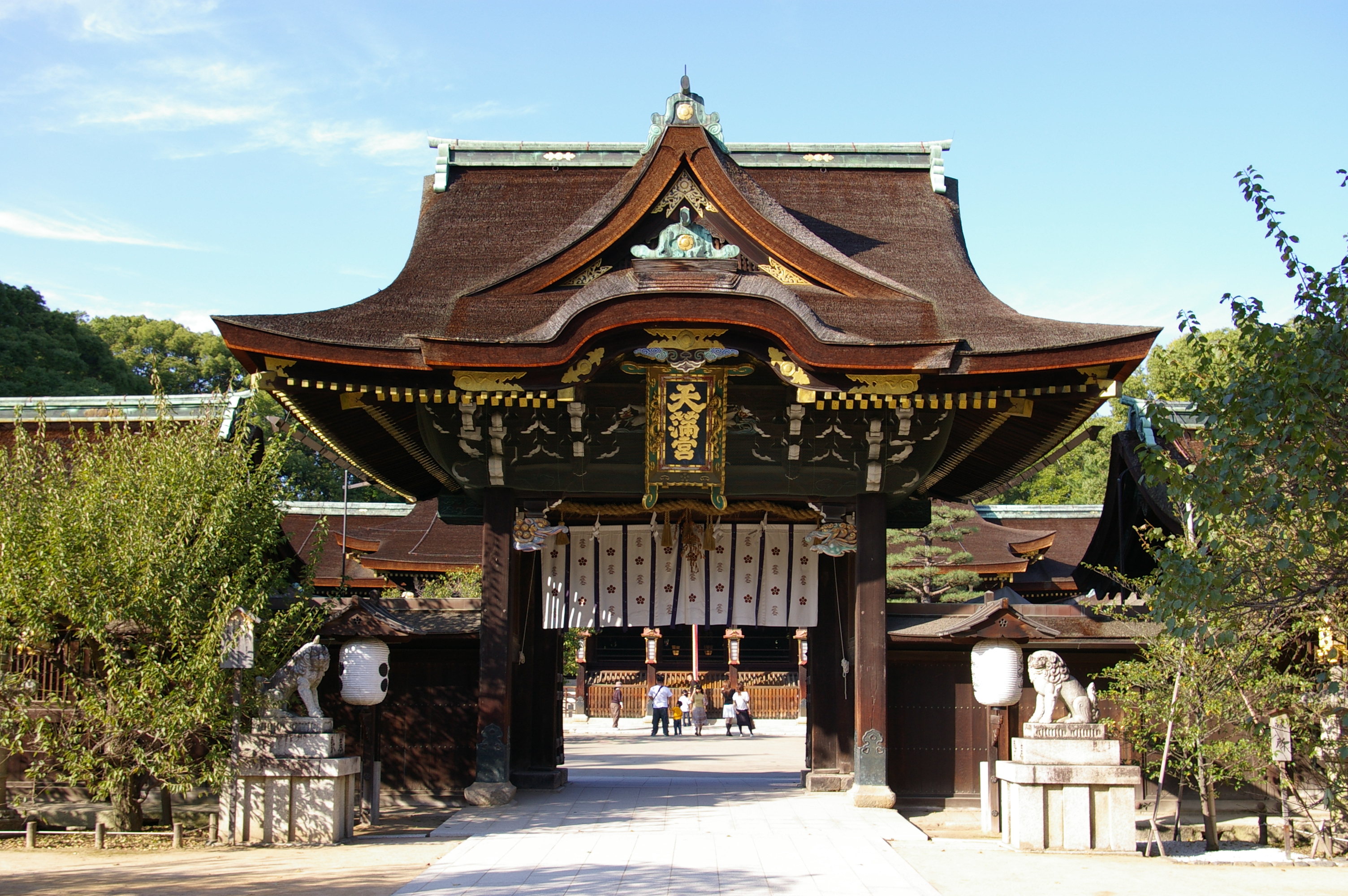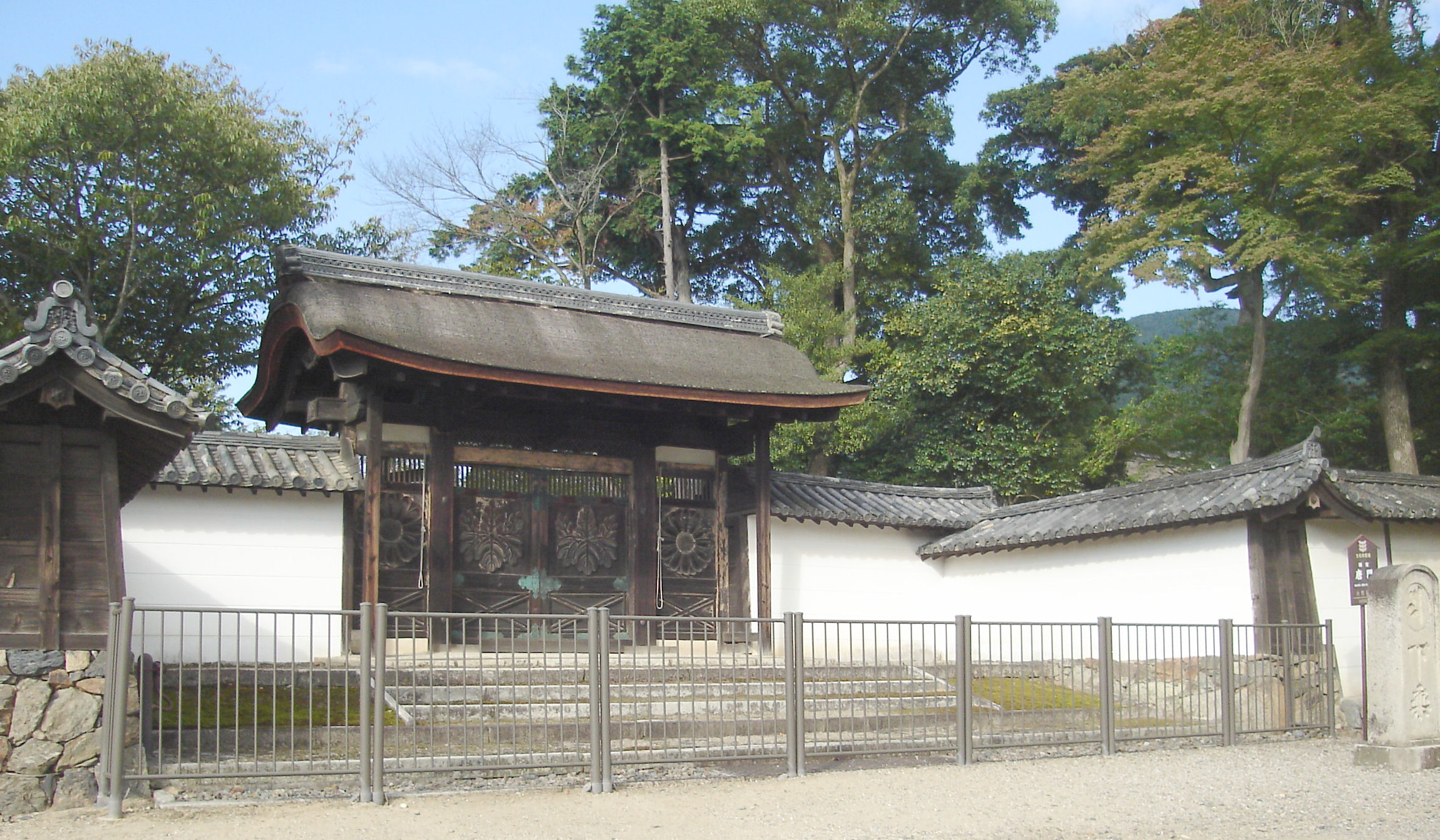Karamon on:
[Wikipedia]
[Google]
[Amazon]
 The is a type of
The is a type of
" JAANUS. Retrieved on June 12, 2009. It was named thus because the word ''kara'' was associated by the Japanese with any type of ornate architecture regardless of origin.
" JAANUS. Retrieved on June 12, 2009. The ''karahafu'' developed during the
 ''Mukaikaramon'' (向唐門) is the most common form of ''karamon'', and features two ''karahafu'' at the front and back of the gate. This type of gate may incorporate a ''karahafu'' in the middle of the roof, or the entire gable itself may be a curved structure.mukaikaramon 向唐門
''Mukaikaramon'' (向唐門) is the most common form of ''karamon'', and features two ''karahafu'' at the front and back of the gate. This type of gate may incorporate a ''karahafu'' in the middle of the roof, or the entire gable itself may be a curved structure.mukaikaramon 向唐門
. JAANUS. Retrieved on June 12, 2009.
 ''Hirakaramon'' (平唐門) are distinguished with two ''karahafu'' on the left and right sides of the gate. This type of gate was originally used at palaces, and was once called ''miyukimon'' (御幸門).
''Hirakaramon'' (平唐門) are distinguished with two ''karahafu'' on the left and right sides of the gate. This type of gate was originally used at palaces, and was once called ''miyukimon'' (御幸門).
. JAANUS. Retrieved on June 12, 2009.
 ''Karayotsuashimon'' (唐四脚門, "Four-legged gate") is an ornate style of ''karamon'' that features four undulating gables on all sides of the gate. A good example of this type of gate can be found at Nikkō Tōshō-gū. This ''karamon'' is decorated with 611 sculptures, including the
''Karayotsuashimon'' (唐四脚門, "Four-legged gate") is an ornate style of ''karamon'' that features four undulating gables on all sides of the gate. A good example of this type of gate can be found at Nikkō Tōshō-gū. This ''karamon'' is decorated with 611 sculptures, including the 日光東照宮・唐門
/ref>
Layouts and Layers: Spatial Arrangements in Japan and Korea
'. Sungkyun Journal of East Asian Studies, Volume 3, No. 2. Retrieved on May 30, 2009. *Parent, Mary Neighbour. (2003).
Japanese Architecture and Art Net Users System
'. {{Shinto shrine Japanese architectural features Gates in Japan
gate
A gate or gateway is a point of entry to or from a space enclosed by walls. The word derived from old Norse "gat" meaning road or path; But other terms include ''yett and port''. The concept originally referred to the gap or hole in the wall ...
seen in Japanese architecture
has been typified by wooden structures, elevated slightly off the ground, with tiled or thatched roofs. Sliding doors (''fusuma'') and other traditional partitions were used in place of walls, allowing the internal configuration of a space to ...
. It is characterized by the usage of '' karahafu'', an undulating bargeboard
Bargeboard (probably from Medieval Latin ''bargus'', or ''barcus'', a scaffold, and not from the now obsolete synonym "vergeboard") or rake fascia is a board fastened to each projecting gable of a roof to give it strength and protection, and to ...
peculiar to Japan. ''Karamon'' are often used at the entrances of Japanese castle
are fortresses constructed primarily of wood and stone. They evolved from the wooden stockades of earlier centuries, and came into their best-known form in the 16th century. Castles in Japan were built to guard important or strategic sites, such ...
s, Buddhist temples
A Buddhist temple or Buddhist monastery is the place of worship for Buddhists, the followers of Buddhism. They include the structures called vihara, chaitya, stupa, wat and pagoda in different regions and languages. Temples in Buddhism represen ...
and Shinto shrine
A is a structure whose main purpose is to house ("enshrine") one or more ''kami'', the deities of the Shinto religion.
Overview
Structurally, a Shinto shrine typically comprises several buildings.
The ''honden''Also called (本殿, meanin ...
s, and have historically been a symbol of authority.
History
Although ''kara'' (唐) can be translated as meaning "China" or "Tang
Tang or TANG most often refers to:
* Tang dynasty
* Tang (drink mix)
Tang or TANG may also refer to:
Chinese states and dynasties
* Jin (Chinese state) (11th century – 376 BC), a state during the Spring and Autumn period, called Tang (唐) ...
", this type of roof with undulating bargeboards first appeared in Japan during the late Heian period
The is the last division of classical Japanese history, running from 794 to 1185. It followed the Nara period, beginning when the 50th emperor, Emperor Kanmu, moved the capital of Japan to Heian-kyō (modern Kyoto). means "peace" in Japan ...
.karahafu 唐破風" JAANUS. Retrieved on June 12, 2009. It was named thus because the word ''kara'' was associated by the Japanese with any type of ornate architecture regardless of origin.
" JAANUS. Retrieved on June 12, 2009. The ''karahafu'' developed during the
Heian period
The is the last division of classical Japanese history, running from 794 to 1185. It followed the Nara period, beginning when the 50th emperor, Emperor Kanmu, moved the capital of Japan to Heian-kyō (modern Kyoto). means "peace" in Japan ...
and is shown in picture scrolls to decorate gates, corridors, and palanquins
The litter is a class of wheelless vehicles, a type of human-powered transport, for the transport of people. Smaller litters may take the form of open chairs or beds carried by two or more carriers, some being enclosed for protection from the el ...
. The oldest existing ''karahafu'' is found at Hōryū-ji
is a Buddhist temple that was once one of the powerful Seven Great Temples, in Ikaruga, Nara Prefecture, Japan. Its full name is , or Learning Temple of the Flourishing Law, the complex serving as both a seminary and monastery.
The temple was ...
temple.
Initially, the ''karahafu'' was used only in temples and aristocratic gateways, but starting from the beginning of the Azuchi–Momoyama period
The was the final phase of the in Japanese history from 1568 to 1600.
After the outbreak of the Ōnin War in 1467, the power of the Ashikaga Shogunate effectively collapsed, marking the start of the chaotic Sengoku period. In 1568, Oda Nobuna ...
, it became an important architectural element in the construction of a ''daimyō
were powerful Japanese magnates, feudal lords who, from the 10th century to the early Meiji period in the middle 19th century, ruled most of Japan from their vast, hereditary land holdings. They were subordinate to the shogun and nominall ...
''s mansions and castles. The ''karamon'' entrance was reserved for the ''shōgun
, officially , was the title of the military dictators of Japan during most of the period spanning from 1185 to 1868. Nominally appointed by the Emperor, shoguns were usually the de facto rulers of the country, though during part of the Kamaku ...
'' during his ''onari'' visits to the retainer, or for the reception of the emperor at shogunate establishments. A structure associated with these social connections naturally imparted special meaning.
''Karamon'' would later become a means to proclaim the prestige of a building and functioned as a symbol of both religious and secular architecture. In the Tokugawa shogunate
The Tokugawa shogunate (, Japanese 徳川幕府 ''Tokugawa bakufu''), also known as the , was the military government of Japan during the Edo period from 1603 to 1868. Nussbaum, Louis-Frédéric. (2005)"''Tokugawa-jidai''"in ''Japan Encyclopedia ...
, the ''karamon'' gates were a powerful symbol of authority reflected in architecture.
Variations
Mukaikaramon
. JAANUS. Retrieved on June 12, 2009.
Hirakaramon
 ''Hirakaramon'' (平唐門) are distinguished with two ''karahafu'' on the left and right sides of the gate. This type of gate was originally used at palaces, and was once called ''miyukimon'' (御幸門).
''Hirakaramon'' (平唐門) are distinguished with two ''karahafu'' on the left and right sides of the gate. This type of gate was originally used at palaces, and was once called ''miyukimon'' (御幸門).. JAANUS. Retrieved on June 12, 2009.
Karayotsuashimon
 ''Karayotsuashimon'' (唐四脚門, "Four-legged gate") is an ornate style of ''karamon'' that features four undulating gables on all sides of the gate. A good example of this type of gate can be found at Nikkō Tōshō-gū. This ''karamon'' is decorated with 611 sculptures, including the
''Karayotsuashimon'' (唐四脚門, "Four-legged gate") is an ornate style of ''karamon'' that features four undulating gables on all sides of the gate. A good example of this type of gate can be found at Nikkō Tōshō-gū. This ''karamon'' is decorated with 611 sculptures, including the Seven Lucky Gods
In Japanese mythology, the Seven Lucky Gods or Seven Gods of Fortune (, shichifukujin in Japanese) are believed to grant good luck and are often represented in netsuke and in artworks. One of the seven (Jurōjin) is said to be based on a historic ...
and the Eight Immortals
The Eight Immortals () are a group of legendary '' xian'' ("immortals") in Chinese mythology. Each immortal's power can be transferred to a vessel () that can bestow life or destroy evil. Together, these eight vessels are called the "Covert Eight ...
./ref>
See also
* Mon (architecture) *Japanese Buddhist architecture
Examples of Buddhist architecture in Japan
Japanese Buddhist architecture is the architecture of Buddhist temples in Japan, consisting of locally developed variants of architectural styles born in China.p=716/ref> After Buddhism arrived from ...
*Buddhist temples in Japan
Buddhist temples or Buddhist monasteries together with Shinto shrines, are considered to be amongst the most numerous, famous, and important religious buildings in Japan.The term "Shinto shrine" is used in opposition to "Buddhist temple" to mir ...
*List of National Treasures of Japan (temples)
A ''list'' is any set of items in a row. List or lists may also refer to:
People
* List (surname)
Organizations
* List College, an undergraduate division of the Jewish Theological Seminary of America
* SC Germania List, German rugby unio ...
Notes
References
*Coaldrake, William. (1996). ''Architecture and Authority in Japan''. London/New York: Routledge. . *Sarvimaki Marja. (2000). ''Structures, Symbols and Meanings: Chinese and Korean Influence on Japanese Architecture''. Helsinki University of Technology, Department of Architecture. . *Sarvimaki Marja. (2003).Layouts and Layers: Spatial Arrangements in Japan and Korea
'. Sungkyun Journal of East Asian Studies, Volume 3, No. 2. Retrieved on May 30, 2009. *Parent, Mary Neighbour. (2003).
Japanese Architecture and Art Net Users System
'. {{Shinto shrine Japanese architectural features Gates in Japan